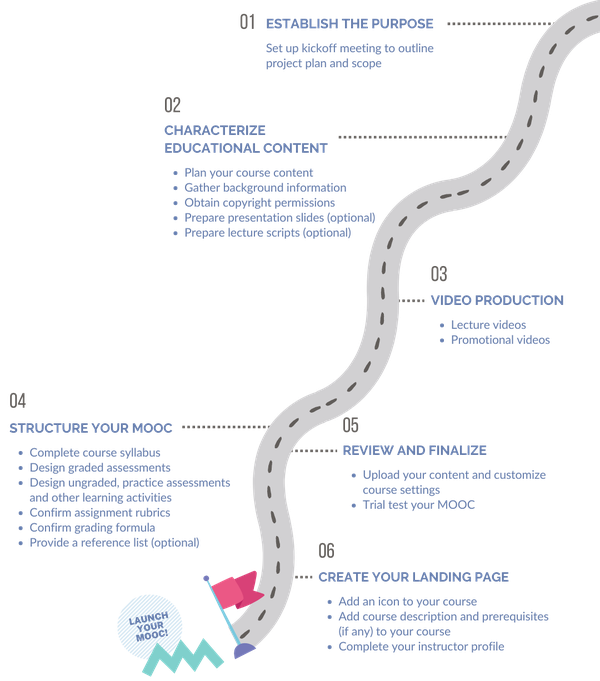How to create a MOOC?
SET UP A CONSULTATION
If you are interested in creating MOOCs, please contact MOOC Unit of the Center for Research and Development of Higher Education. After learning about your needs and expectations through kickoff meeting, we will outline a proposal accordingly. We also offer professional consultation on online course development, non-formal education as well as creative production.
As UTokyo MOOC is a university-wide project, prior approval from your affiliated department is required to submit a proposal. Your course development proposal will then undergo a simple review at our Center for quality assurance. We would communicate and consult with you on syllabus, videos filming, assessment rubrics and many others.
MAKE A PROPOSAL
To ensure quality assurance, project specialists and instructional designers from the MOOC Unit will lead you through development from concept to launch of your course. The followings will be discussed in the planning phase.
| Target learner | Grade, country or region, occupation and literacy level |
| Learning objectives | What students are expected to learn |
| Course purpose | Attracting international students (undergraduate and postgraduate), disseminating research results, disseminating content of educational practices, etc. |
| Course length | The average length of a MOOC is about four to six weeks, but some MOOCs are longer. Most provide an estimate of the weekly time commitment, although this may vary significantly from one learner to another. Students, on average, dedicate two to four hours a week to the course. MOOCs have a variety of learning components, such as videos, reading activities, lectures, and discussion platforms. Most MOOCs also have assessments, such as quizzes, tests, or peer-reviewed assignments. |
| Course format | Whether the course is delivered by one or multiple instructors |
VIDEO PRODUCTION
Using the right (or wrong) style of video can have a major impact on the performance of your content. While MOOCs are typically shot in front of a compelling backdrop with graphics added, it is recommended to mix different video styles in creating content. Video styles include but not limited to the following:
・ Interview videos made with one fixed camera, or can be shot on multiple cameras and edited together for a more dynamic feel
・ Animated videos to illustrate a concept in a practical, consumable way
・ Text overlay videos that pairs imagery with overlaid text to create a felling of dynamic movement
・ 360-degree video that records a view in every direction at the same time
Using a combination of different video styles will make your course content engaging enough to create a connection with learners and hold their attention for long. It also reduces the burden on instructors when compared to shooting talking head videos only.
For example, dialogues with Japanese architects and aerial shots of actual buildings are included in our MOOC "Four Facet of Contemporary Japanese Architecture". Despite the course is delivered in Japanese (with English subtitles), the high quality of lecture videos has been well received by international learners.
We will recommend the best video style based on the type of course you are creating, the sort of audience you are reaching out to, or your intended goal for the video. If desired, we can edit your existing lecture videos for MOOC use. Indoor filming will be done at Media Studio, iii UTokyo in 2-3 consecutive day. Outdoor shooting will be conducted with the help of video production companies.
CHARACTERIZE EDUCATIONAL CONTENT
Roughly 40 questions are needed for both graded and ungraded assessments. A mixture of formative and summative assessments helps scale quality practice and feedback opportunities to learners.
In preparing for your presentation slides, please identify copyright holders of materials adopted and obtain copyright permission. Our Center provide assistance with the process, if deemed necessary. We also provide a fixed budget for presentation design services to help make your slides stand out. Hiring TAs who have disciplinary knowledge to help create quizzes and prepare presentation slides is recommended.
Milestone
Below is a milestone which mark specific points along a MOOC project timeline.


